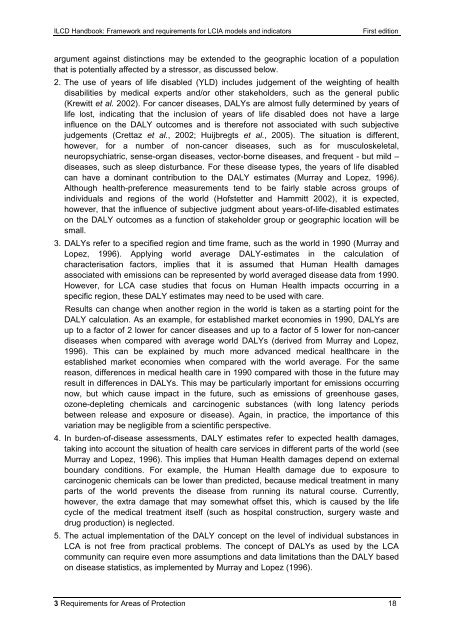ILCD Handbook: Framework and requirements for LCIA models and ...
ILCD Handbook: Framework and requirements for LCIA models and ...
ILCD Handbook: Framework and requirements for LCIA models and ...
Create successful ePaper yourself
Turn your PDF publications into a flip-book with our unique Google optimized e-Paper software.
<strong>ILCD</strong> <strong>H<strong>and</strong>book</strong>: <strong>Framework</strong> <strong>and</strong> <strong>requirements</strong> <strong>for</strong> <strong>LCIA</strong> <strong>models</strong> <strong>and</strong> indicators First edition<br />
argument against distinctions may be extended to the geographic location of a population<br />
that is potentially affected by a stressor, as discussed below.<br />
2. The use of years of life disabled (YLD) includes judgement of the weighting of health<br />
disabilities by medical experts <strong>and</strong>/or other stakeholders, such as the general public<br />
(Krewitt et al. 2002). For cancer diseases, DALYs are almost fully determined by years of<br />
life lost, indicating that the inclusion of years of life disabled does not have a large<br />
influence on the DALY outcomes <strong>and</strong> is there<strong>for</strong>e not associated with such subjective<br />
judgements (Crettaz et al., 2002; Huijbregts et al., 2005). The situation is different,<br />
however, <strong>for</strong> a number of non-cancer diseases, such as <strong>for</strong> musculoskeletal,<br />
neuropsychiatric, sense-organ diseases, vector-borne diseases, <strong>and</strong> frequent - but mild –<br />
diseases, such as sleep disturbance. For these disease types, the years of life disabled<br />
can have a dominant contribution to the DALY estimates (Murray <strong>and</strong> Lopez, 1996).<br />
Although health-preference measurements tend to be fairly stable across groups of<br />
individuals <strong>and</strong> regions of the world (Hofstetter <strong>and</strong> Hammitt 2002), it is expected,<br />
however, that the influence of subjective judgment about years-of-life-disabled estimates<br />
on the DALY outcomes as a function of stakeholder group or geographic location will be<br />
small.<br />
3. DALYs refer to a specified region <strong>and</strong> time frame, such as the world in 1990 (Murray <strong>and</strong><br />
Lopez, 1996). Applying world average DALY-estimates in the calculation of<br />
characterisation factors, implies that it is assumed that Human Health damages<br />
associated with emissions can be represented by world averaged disease data from 1990.<br />
However, <strong>for</strong> LCA case studies that focus on Human Health impacts occurring in a<br />
specific region, these DALY estimates may need to be used with care.<br />
Results can change when another region in the world is taken as a starting point <strong>for</strong> the<br />
DALY calculation. As an example, <strong>for</strong> established market economies in 1990, DALYs are<br />
up to a factor of 2 lower <strong>for</strong> cancer diseases <strong>and</strong> up to a factor of 5 lower <strong>for</strong> non-cancer<br />
diseases when compared with average world DALYs (derived from Murray <strong>and</strong> Lopez,<br />
1996). This can be explained by much more advanced medical healthcare in the<br />
established market economies when compared with the world average. For the same<br />
reason, differences in medical health care in 1990 compared with those in the future may<br />
result in differences in DALYs. This may be particularly important <strong>for</strong> emissions occurring<br />
now, but which cause impact in the future, such as emissions of greenhouse gases,<br />
ozone-depleting chemicals <strong>and</strong> carcinogenic substances (with long latency periods<br />
between release <strong>and</strong> exposure or disease). Again, in practice, the importance of this<br />
variation may be negligible from a scientific perspective.<br />
4. In burden-of-disease assessments, DALY estimates refer to expected health damages,<br />
taking into account the situation of health care services in different parts of the world (see<br />
Murray <strong>and</strong> Lopez, 1996). This implies that Human Health damages depend on external<br />
boundary conditions. For example, the Human Health damage due to exposure to<br />
carcinogenic chemicals can be lower than predicted, because medical treatment in many<br />
parts of the world prevents the disease from running its natural course. Currently,<br />
however, the extra damage that may somewhat offset this, which is caused by the life<br />
cycle of the medical treatment itself (such as hospital construction, surgery waste <strong>and</strong><br />
drug production) is neglected.<br />
5. The actual implementation of the DALY concept on the level of individual substances in<br />
LCA is not free from practical problems. The concept of DALYs as used by the LCA<br />
community can require even more assumptions <strong>and</strong> data limitations than the DALY based<br />
on disease statistics, as implemented by Murray <strong>and</strong> Lopez (1996).<br />
3 Requirements <strong>for</strong> Areas of Protection 18



